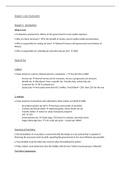Summary
Summary Taxation 298 - Complete First Semester Notes
- Course
- Taxation 298 (TAX298)
- Institution
- Stellenbosch University (SUN)
A complete, well written summary of Tax298 semester 1 work including tax act paragraph references and explanations. Summaries of Chapters 1,2,3,4,5,8,21.
[Show more]



